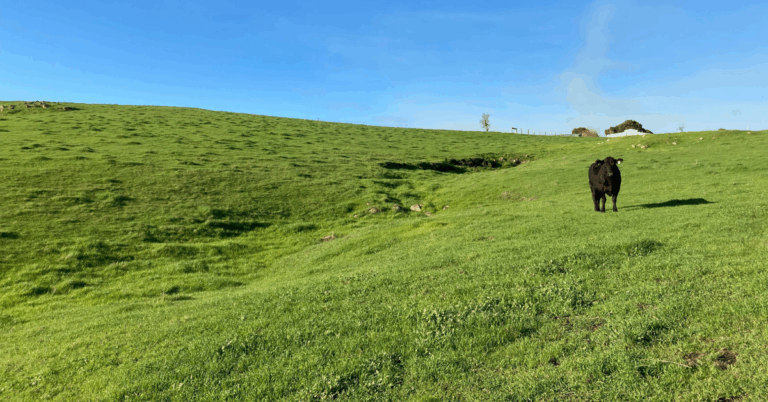
Supplementary feeding of livestock is a costly but necessary part of farming in Western Australia.
To get the best return on supplement, farmers need an understanding of nutritional requirements and its components. This allows them to ensure each component can be filled by pasture at different times of the year and plug seasonal gaps with the most appropriate and cheapest feed.
Animal needs and pasture components are key topics being discussed by livestock specialist Jeisane Accioly (pictured below) during the latest round of the evergreen Grazing Matcher program. It brings together eight South West grazing enterprises for regular meetings over 12 months to improve grazing management and animal production.
Jeisane said the first step to understanding how well your pasture was meeting the needs of livestock was to estimate dry matter requirements for different livestock classes.
How much dry matter?
“The amount of dry matter they need to eat each day is anywhere between 1.5 per cent and 4 per cent of their liveweight depending on the class of stock and the quality of feed,” jeisane said.
To convert dry matter requirements into kilograms of feed, Jeisane said producers needed to consider how dry matter content of pasture changed throughout the year.
“From the break of season to early spring, pasture is usually about 80-90 per cent water and 10-20 per cent dry matter. So, assuming 10 per cent dry matter, a kilo of pasture will only contain 100 grams of dry matter and the rest will be water,” she said.
Jeisane compared it to eating watermelon, suggesting they would need to eat a lot of melon to satisfy nutritional requirements. Hence, we often see animals eating well into the night in winter, which is a good indication they are hungry.
Livestock tend to lose condition during this period if not supplemented.
However, before supplementing with hay or silage, it’s good to know what component the pasture is lacking. In winter the answer is most likely to be fibre.

During winter
“Ruminants need fibre to digest properly. Increasing fibre intake during periods of lush pasture by supplementing with hay, or even straw, slows down the digestion and helps the animal use the other nutrients (energy and protein) that are usually high at these times,” she said.
“You can see whether they have enough fibre by monitoring their faeces. If it’s too watery or they have a wet bum they will need more fibre.
“Animals usually know how to balance their diet, so if you have hay or straw in the paddock and they need fibre, they usually “self-medicate” and eat what they need.”
As dry matter increases through the season, so does fibre in the pasture, so animals will stop eating the extra roughage offered. However, in some cold and wet years they might need fibre through to late August.
Continued monitoring of behaviour, body condition and faeces will help assess when you can stop feeding out fibre.
During spring
In spring, pasture has a reasonable balance between fibre, energy and protein and can meet animal requirements without any supplementation. However, this period of balance is often short, perhaps only a few weeks.
In late spring or early summer when plants go to flower, a marked drop in energy and protein and an increase in fibre occurs. This change can happen very quickly and affect the quality of conserved fodder.
During summer and autumn
This trend continues into summer and autumn, when dry pasture has plenty of fibre but is lower in energy and protein. At these times, fibre content in pasture can be a major barrier to nutrition.
“In summer, high fibre content in pasture makes it harder to digest so animals get full and you will see them stop eating,” she said.
“However, because the pasture is low in energy and protein, they often stop eating before they have satisfied nutritional requirements. Digestion actually uses up energy which further diminishes energy available for production and can lead to weight loss.
“This also explains why poor-quality hay (low in energy and protein) is often left uneaten in summer and autumn.
“So, during the summer-autumn period, supplements need to be high in energy and protein, such as pellets and grains. Again, monitoring body condition and weight helps to check whether you’ve got the balance right.”
The correct supplement will make livestock utilise dry, low quality pasture better and help them hold condition. Given the variation in supplementary feed quality, it makes sense to have it feed-tested to ensure you are meeting animal requirements and not wasting your money.
Understanding energy and protein needs
To understand how much energy and protein animals need depends on the class of stock.
“Lactating females typically require considerably more energy and protein compared to a dry cow or bull, especially if they need to be in good condition to re-join or they are already pregnant,” Jeisane said.
“Weaners that need to be finished also need relatively good nutrition. There are minimum requirements published for different classes.”
In summary
Pasture dry matter needs to be monitored to estimate whether livestock have enough feed to maintain condition.
Then, to fine-tune estimates, producers need to consider the amount of protein, energy and fibre in the feed and understand that there is a narrow window usually in mid to late spring when all three are satisfied and supplementation will not be required.
At other times of the year, you will almost always need to supplement with something: either fibre in winter or energy and protein in summer and autumn. After estimates and calculations have been made, it’s best to monitor animal condition, liveweight, faeces and behaviour, and adapt supplementation where required.
For more information on feed requirements for different animal classes, see Agriculture Victoria’s Feeding Livestock webpage.
The Grazing Matcher Program is supported by South West NRM, through funding from the Australian Government’s Natural Heritage Trust under the Climate-Smart Agriculture Program.
